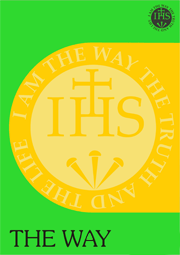|

| |
IMAGINATIVE PATHWAYS
Please click here to subscribe to The
Way, Electronic subscribers, click here to download this issue. You will need the password that we e-mailed to you. Contents The Composition of Place: Creating Space for an Encounter Why is one encouraged to make the 'composition of place'-to imagine the surroundings-in the Spiritual Exercises? Is this a higher or a lower form of prayer? This article explores how some illustrations dating from Ignatius' lifetime help us answer such questions. Download this article in
Word format by clicking here, The 'Terrible Sonnets' of Gerard Manley Hopkins and the Spirituality of Depression Hopkins' so-called 'Terrible Sonnets' emerged from profound mental suffering, of a kind that would probably now be identified as depression. What religious sense can we make of them? How can these texts speak to those suffering from depression today? Poetry and Prayer Beyond Words Graeme Watson takes the example of George Herbert, the seventeenth-century English poet and priest, to show how poetry opens us to the mystery of a divine silence in which descriptive language breaks down. Gwen John: Her Art and Spirituality Gwen John has always been overshadowed by her more famous brother, but her work, at least after her conversion to Catholicism in her thirties, is marked by a quite distinctive spirituality. Tessa Frank here explores this dimension of Gwen John's work. The Vocation of Denise Levertov Denise Levertov, who died ten years ago this year, found her way through the years of protest against the Vietnam war and nuclear weapons to Catholicism. Dana Greene here explores how Levertov's vocation gradually matured. The First Method of Prayer :Prayerful Self-Monitoring In the Fourth Week of the Spiritual Exercises, Ignatius gives us three 'Methods of Prayer' that are perhaps still too little known. In particular, the first of the three can enrich our sense of prayerful moral responsibility. On Preparation for Prayer One of the earliest and most interesting commentators on the Exercises gives his own distinctive interpretation of the Additional Directions, the Preparatory Prayer, and the Preludes.
Book Reviews on the collected essays of Joseph Veale, the noted Irish Ignatian directoron The Blackwell Companion to Christian Spirituality on on the Jesuits and the arts on on retreats in daily life on on the soul, and on retreat-giving for beginners on spirituality for the single person on on the Bible and pastoral care on on the Bible, homosexuality and trends in contemporary Roman Catholicism on on demons in early monasticism on on theology and bioethics on on French Catholic culture in the Jazz Age on on conversations with Rowan Williams
From the Foreword 'CREATING SPACE FOR AN ENCOUNTER is Nicolas Standaert's subtitle for his article on the Ignatian composition of place in this issue. In one sense, the phrase applies, of course, to any spiritual practice. But it has a special relevance to the various imaginative pathways through which Ignatius draws us into prayer: not only the composition of place, but also the preparatory prayer 'that all my intentions, actions and operations should be purely ordered to the service and praise of His Divine Majesty' (Exx 46) and the various Additional Directions. Indeed, in the First Method of Prayer, explored in this issue by Luis Raśl Cruz, Ignatius almost suggests that what he offers is merely ways of preparing for prayer-'how the soul should prepare itself and benefit'-rather than forms of prayer in themselves. Characteristically, he is suggesting that what really matters is up to the freedom of God and the freedom of the creature. A wise spiritual guide does not attempt to prescribe. The ways Ignatius himself suggests involve the imagination: the picturing of the scene, the sense of the Divine Majesty looking at me (Exx 75), even the reliving of our recent past. We can surely enrich our experience of prayer by drawing on our experience of artistic beauty. Hence there are also articles in this number that look at the spirituality of three poets and one painter: George Herbert, Gerard Manley Hopkins, Denise Levertov and Gwen John. These four figures, of course, stand for many others. 'Ignatian prayer' has often been presented as somehow forced and regimented-there are hints of the criticism even in the early writings of Nadal and Gagliardi presented in this issue. Perhaps some retreat directors-one thinks of James Joyce's preacher-have been guilty along such lines. But Ignatius invites us to use our imaginations freely. He does not tell us what the road to Bethlehem looks like. Rather he leaves us to find our own road, indeed to find the pathway to the heavenly Jerusalem.Philip Endean SJ
Please click here to subscribe to The
Way, | ||
| |






|


